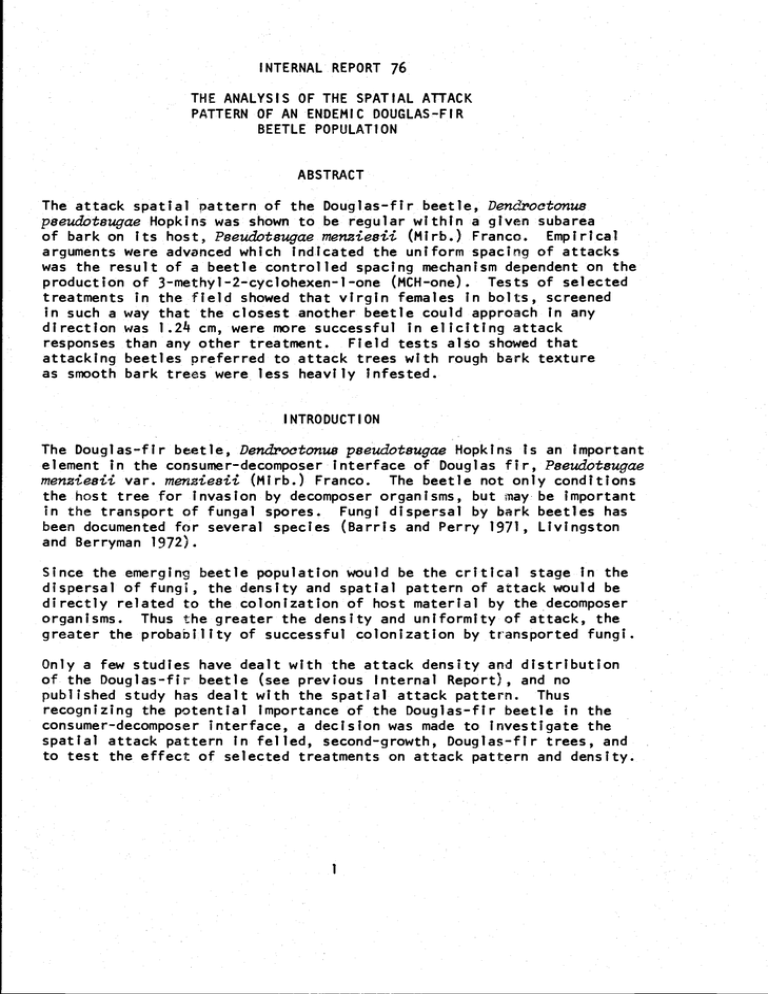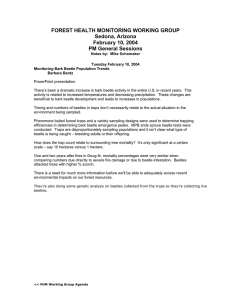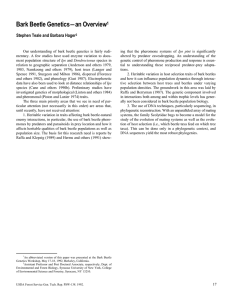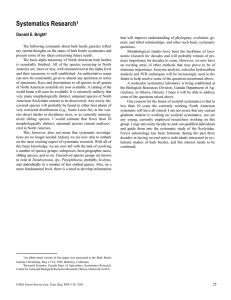The attack spatial pattern of the Douglas-fir
advertisement

INTERNAL REPORT 76 THE ANALYSIS OF THE SPATIAL ATTACK PATTERN OF AN ENDEMIC DOUGLAS-FIR BEETLE POPULATION ABSTRACT The attack spatial pattern of the Douglas-fir beetle, Dendwroetonus pseudotsugae Hopkins was shown to be regular within a given subarea of bark on its host, Pseudoteugae menzieeii (Mirb.) Franco. Empirical arguments were advanced which Indicated the uniform spacing of attacks was the result of a beetle controlled spacing mechanism dependent on the production of 3-methyl-2-cyclohexen-l-one (MCH-one). Tests of selected treatments in the field showed that virgin females in bolts, screened in such a way that the closest another beetle could approach in any direction was 1.24 cm, were more successful in eliciting attack responses than any other treatment. Field tests also showed that attacking beetles preferred to attack trees with rough bark texture as smooth bark trees were less heavily Infested. INTRODUCTION The Douglas-fir beetle, Dendroetonue pseudotsugae Hopkins is an important element in the consumer-decomposer interface of Douglas fir, Pseudotsugae menziesii var. menziesii (Mirb.) Franco. The beetle not only conditions the host tree for invasion by decomposer organisms, but may be important in the transport of fungal spores. Fungi dispersal by bark beetles has been documented for several species (Barris and Perry 1971, Livingston and Berryman 1972). Since the emerging beetle population would be the critical stage in the dispersal of fungi, the density and spatial pattern of attack would be directly related to the colonization of host material by the decomposer organisms. Thus the greater the density and uniformity of attack, the greater the probability of successful colonization by transported fungi. Only a few studies have dealt with the attack density and distribution of the Douglas-fir beetle (see previous Internal Report), and no published study has dealt with the spatial attack pattern. Thus recognizing the potential Importance of the Douglas-fir beetle in consumer-decomposer interface, a decision was made to investigate the the spatial attack pattern in felled, second-growth, Douglas-fir trees, and to test the effect of selected treatments on attack pattern and density. MATERIALS AND METHODS Site Preparation and Data Collection The objective of this study was to investigate the spatial attack pattern of an endemic Douglas-fir beetle population in felled, second-growth Douglas-fir trees. Accordingly, trees about 50 years old with an average DBH of 26.7 cm were located in an area approximately seven kilometers east of Cedar Falls, Washington, in the City of Seattle watershed. The selected site sustained an endemic beetle population that was maintained by periodic thinning operations in the area. In mid-April twenty trees were randomly selected and felled. A ring analysis indicated crown closure had taken place fifteen to twenty years earlier. Five of the test trees were cut into bolts for controlled experiments; the other fifteen trees were left in the field to be naturally infested by the emerging Douglas-fir beetle population. The infestation period was closely monitored, and in mid-June after the initial beetle flight, data were collected on attack density and location of individual attacks. This information was obtained from each tree by collecting data from four, 576 cm2 sampling quadrats. Samples 1, 2, and 3 were located in the lower, middle, and upper bole respectively, and were spaced equidistant from each other. Sample 4 was located midway between and 2. The quadrats were situated on the upper side of the log in such I a manner that each quadrat extended one foot on either side of a center line which bisected the log. A 360° protractor was then placed in the center of a quadrat, with zero degrees oriented towards the crown on the center line. The angle of each attack from zero degrees and its distance from the center of the quadrat were then recorded. Thus the exact position of each attack within each sample was determined. This type of analysis enabled the construction of "attack maps" by plotting the position of attacks within a quadrat on paper. Each "map" was then divided circumferentially into four 15.2 X 61.0 cm subsamples with the long axis of each oriented along the bole. Thus the samples for each tree consisted of four height samples, each containing four circumferential samples. Analysis of the Attack Spatial Pattern The spatial attack pattern of the Douglas-fir beetle was determined using Morisita's index Ia (Morisita 1959). In order to use this index to investigate spatial pattern, it was assumed the population could be divided into subareas; that individuals within these subareas were randomly or uniformly distributed; and that the subareas were large compared to quadrat size (Morisita 1959). These assumptions are normally quite restrictive except where the subareas are discrete physical units (Stiteler and Patil 1971). If the assumptions were not flagrantly violated then the index could be used to detect spatial pattern. This is possible because I changes systematically with change in quadrat size and is independent of changes in density. The index is based on Simpson's (1949) measure of diversity. Simpson's diversity indice gives the probability that two objects will be of the same type when selected at random, without replacement, from the whole 2 population. This probability s E i-I can be represented by: ni (ni - l ) /N (N - 1) where ni represents types of objects and N = Zni. Simpson considered diversity low when this probability was great, and high when It was small. Morisita applied this Idea to quadrat sampling by taking q quadrats at random from an area, and representing the individuals from the ith quadrat as xi(i = 1, 2, 3, q) where Exi = N. Thus, the probability that any two Individuals, chosen at random, belong to the same quadrat is: , q E xi( - 1) /N (N - 1) i=1 Therefore, 6 will take a fixed value independent of N, density. And putting I6 = q6 , IS will be a measure of dispersion. When a population with a random pattern is sampled, the probability that an individual will come from one quadrat is the same for all quadrats, thus 6 will be equal to l/q, and I6 will be equal to one. When the pattern is aggregated, then Individuals will be concentrated In a few quadrats and 6 will be great, thus I6 will be greater than one. If all of the individuals are in a single quadrat, then I6 will equal located If the individuals in the the quadrats, 6 will be small q. population are distributed equally among and the pattern will be regular. The value for I6 if maximum regularity exists is I - (q - 1/N - 1). An example of the effective use of this index is Hariston and his coworkers' (1971) Investigation of aggregation patterns in soil arthropods. Bark Roughness and Attack Density Each of the felled of smooth, trees was qualitatively classified into bark roughness intermediate or rough. In this subjective classification, trees with smooth bark had fewer bark niches per square foot than those with rough bark (Figure 1). Those classified as intermediate possessed bark texture somewhat between the two extremes. Since classification was subjective, only data from rough and smooth bark trees were used for comparative purposes. Each tree also was classified arbitrarily as being successfully Infested (more than one attack per 365.8 cm2) or unsuccessfully infested (less than one attack per 365.8 cm2). The effect of bark roughness on successful infestation was then tested using a nonparametric analysis of percentages (Sokal and Rohlf 1969). Attack Response to Selected Treatments It was suspected that many factors other than bark texture might affect beetle attack behavior exemplified by the spatial attack pattern. These factors include behavioral responses conditioned by pheromones produced during male-female interaction during host selection and colonization. 3 One candidate pheromone which possesses a repellancy property (Rudinsky 1968) is MCH-one. In order to investigate this pheromone and other possible malefemale Interactions the following treatments were tested in the field: 1. MCH-one (3-methyl-2-cyclohexen-l-one) 0.5 conc. 2. MCH-one 0.5 conc. and screened females 3. females screened 4. females unscreened 5. females and males 6. control (bolts untreated) Each treatment was effected on five bolts from different trees. Each bolt was divided into four quadrats with the layout in Figure 2. The circles represent artificial bark niches 4.0 mm in diameter, and the x's (treatment niches), the niche in which the treatment is placed. In A and C the first niches were 1.27 cm from the treatment, the second 2.54 cm, and the remaining 2.54 cm from each other. In B and D, all the niches were 2.54 cm apart. In treatments two, three, and four, the treatment niches were screened to prevent other beetles from approaching in any direction, in quadrats A and C closer than 1.27 cm away from the treatment niche, and 1.54 cm in quadrats B and D. was delivered using two dram bottles with holes drilled in the caps through which a single capillary tube extended into the medium. The MCH-one The exposed end of the tube was placed at the opening of the treatment Lastly, the bolts from each treatment were placed in a circle equidistant from an attractive source (Douglure and fresh bolts). Each treatment was spaced approximately 100 m apart in the second-growth niche. Douglas-fir stand. Data were the number and position of attacks. Analysis was a mixed model factorial treatment design (Table 1). Treatments were considered fixed and bolts random. Differences in bolts and treatments were tested using the Student-Newman-Keuls test. collected or, by means of an ANOVA using RESULTS Analysis of the Attack Spatial Pattern The analysis of the spatial pattern of attacks was investigated using the change in Morisita's index of dispersion (IS) with change in quadrat size. The results are given in Table 2 and Figure 3. The results show that IS Increases from less than one to one systematically with increase in quadrat size. This Indicates that attacks are regularly spaced within a given subarea (Morisita 1959). The Effect of Bark Roughness on Successful Infestation Differences between successful and unsuccessful bark beetle attack as related to rough and smooth bark trees was tested using an analysis of proportion test (see Materials and Methods). A tree was considered successfully infested if it had an attack density greater than one per square foot, and unsuccessfully attacked if it had less than one attack per square foot. The results are given in Table 3, and indicate that there are significant differences in successful infestation between trees 4 with smooth and rough bark. Attack Response to Selected Treatments Differences in the mean level of attack due to the selected treatments were tested using ANOVA. The results are given in Table 4. The effects bolts, treatments, and their interaction were all significant. Bolts from a single tree (A) accounted for the significant variation in bolts. Also, a single treatment, unscreened females, accounted for the significant variation in treatments. This treatment was the only one which due to elicited a beetle response significantly different from the control. Unscreened females and bolts from tree A together accounted for the significant interaction. DISCUSSION Attack Spatial Pattern The change of Morisita's index of dispersion with change In quadrat size indicated that attacks were somewhat regularly spaced in any small subarea within the infested portion of a tree. This regular pattern may be due to host factors, beetle controlled factors, or a combination of the two. A combination of host and beetle factors determining attack spatial pattern is likely in some species of Dendroctonus. This Is possible because groups of individual beetles are able to regulate attack density. An example of a density regulator is the pheromone, verbenone, produced by male southern pine beetles. When the concentration of this pheromone becomes great, the responding population "switches" and attacks the next nearest host. In the case of this species, territoriality of individuals may not be as important as overcoming host resistance. Evidence of the importance of overcoming host resistance is provided by the meandering egg gallery pattern which Is very effective in girdling the tree. Therefore, so that some survival from intraspecific competition is insured after the host is overcome, the repellant verbenone becomes effective, and switching of the attack to the next nearest host takes place. Accordingly, a regular attack pattern would not be expected unless potential attack sites were regularly distributed. On the other hand, the Douglas-fir beetle is not faced with the problem of overcoming host resistance, at least not in endemic populations. Thus, the species has every opportunity to exploit survival from intraspecific competition through territorial behavior of individual beetles. If this is the case, then attacks would be spaced in such a way that there would be as little interference between larvae from separate egg galleries as possible. The egg gallery of this species, being relatively straight and parallel to the long axis of the phloem cells, would help facilitate this. There is never any random crossing of egg galleries as there is with the southern pine beetle. Further evidence for maximization of survival from intraspecific competition is the fact that at high attack densities, the length of egg galleries and the number of eggs laid per Inch of egg gallery may be significantly reduced (McMullen and Atkins 1962). One way to obtain optimum attack spacing, so that intraspecific competition is minimized, would be to produce a pheromone with a short-range repellant effect. It can be imagined that when this pheromone is present in high concentrations it could cause switching of attack to the other host similar to verbenone in southern pine beetle populations. It is also possible that host switching might take place at different levels of concentration depending both on population density and availability of host material. A Douglas-fir beetle pheromone which ap ears to possess these qualities is 3-methyl-2-cyclohexen-l-one (MCH-one). Male beetles produce relatively large amounts of this chemical, while female beetles produce lesser amounts (G. Pitman, personal communication). The fact that both sexes produce this pheromone is important because male beetles may leave the female after mating. In this situation males may be responsible for initial spacing, as well as eliciting host switching, but the females are able to maintain minimum spacing after mating by releasing low concentrations of the pheromone. Further evidence that this pheromone may be responsible for spacing comes from studies by the U. S. Forest Service which have shown that the chemical possesses short-range as opposed to long-range repellancy (G. Pitman, personal communication). The same study has also indicated that logs treated with MCH-one have better brood survival due to the reduction of intraspecific competition than untreated logs. All of these facts together provide strong evidence that MCH-one may be responsible for attack spacing and in turn reduce Intraspecific competition. Since host selection and colonization is a dynamic process, and takes place over several days, attack spacing would not be expected to be perfectly regular. For instance, death or reemergence of female beetles would leave some successfully attacked areas uninfluenced by a spacing mechanism, thus additional attacks within this area would then be spaced without reference to the initial attacks. Situations like this would allow variation from perfectly uniform attack spacing and could produce results similar to those obtained in this study. Attack Response to Selected Treatments The field experiment to test attack response to selected treatments showed that virgin females screened in such a way that the minimum distance males were. highly attracThe results also indicate that male-female Interaction is in some way necessary to cause cessation of attractiveness. Lastly, the were allowed to approach from any direction was 1.27 cm, tive to other females. results showed that MCH-one was effective In preventing attacks when used in combination with screened virgin females. All of these results tend to support the theory that some type of beetle controlled response dependent on male-female Interaction exists which either causes short-range repellancy or a "masking of attrac.tancy" (Rudinsky 1968). Considering the earlier discussion, short-range repellancy seems to be a likely candidate, and MCH-one is circumstantially believed to be an Integral part. 6 The results of this experiment must be interpreted cautiously due to possible sources of variation not accounted for in the experimental design. One such source may have been due to the use of beetles that had been stored at low temperatures before introduction into the bolts. Previous studies (Atkins 1959), have shown that cold storage can significantly effect beetle behavior. Another source of variation may be the use of MCH-one concentrations that possess no direct relationship to those present in Douglas-fir beetle populations. In any case, the magnitude of difference between the screened female treatment and the others is large enough to be considered significant. -lost Factors and Attack Response The experiment previously mentioned, indicated that one belt was much more highly attractive in combination with screened virgin female beetles than any other bolt. The reason for this significant interaction or "synergism" is not apparent. It could be due to a number of factors including the nature of the host volatiles, or the quality of pheromones produced after feeding. A separate experiment indicated that the nature of the bark texture was an indicator of suitability for successful infestation. The results showed that rough bark trees were preferred by the attacking population. The reason for this preference is again unknown, and is probably the result of a number of factors, of which two possibilities were mentioned above. It is important to note that bark roughness itself is probably not important, but is only the result of other important factors since only a few bark by attacks. niches in trees with smooth bark texture were occupied SUMMARY 1. The attack spatial pattern was shown to be regular. Empirical arguments were advanced which indicated the uniform spacing of attacks was the result of a beetle controlled spacing mechanism dependent on the production of the pheromone 3-methyl-2-cyclohexen-l-one (MCH-one). 2. Tests of selected treatments in the field showed that virgin females in bolts, screened in such a way that the closest another beetle could approach in any direction was 1.24 cm, were more successful in eliciting attack responses than any other treatment. 3. Field tests also showed that attacking beetles preferred to attack trees with the rough bark textures as smooth bark textures were less heavily infested. 7 REFERENCES ATKINS, M. D. 1959. A study of the Douglas-fir beetle, Dendroctonus Peeudoteugae Hopk. (Coleoptera:Scolytidae). I Flight preparation and response. Can. Ent. 91:283-291. BARRIS, S. J. and T. PERRY. 1971. Gland cells and fungi associated with prothoracic mycangium of Dendroetonus adjunetua (Coleoptera: Scolytidae). Annls. Ent. Soc. Am. 64:123-126. R. L. and A. A. BERRYMAN. 1972. engraver, SaoZytue ventraZis Can. Ent. 104:1793-1800. LIVINGSTON, In the fir Fungus transport structures (Coleoptera:Scolytidae). L. H. and M. D. ATKINS. 1961. Intraspecific competition as a factor in the natural control of the Douglas-fir beetle. For. Sci. McMULLEN, 7:197-203. MORISITA, M. 1959. Measuring the dispersion of individuals and analysis of the distributional patterns. Mem. Fac. Sci. Kyushu Univ. (Ser. E) 2:215-235. RUDINSKY, J. A. 1968. Pheromone-mask by the female Dendrootonue pseudoteugae Hopk., an attraction regulator (Coleoptera:Scolytidae). Pan-Pac. Ent. 44:248-250. SIMPSON, E. H. SOKAL, R. R. and 1949. Measurement of diversity. F. J. ROHLF. 776 p. 1969. Biometry. Nature 163:688. W. H. Freeman and Co., San Francisco. STITELER, W. M. and G. P. PATIL. Variance-to-mean ratio and 1971. Morisita's index as measures of spatial patterns in ecological populations. IN G. P. Patil, E. C. Peilou and W. E. Waters [eds.] Statistical Ecology Volume I: Spatial patterns and statistical distributions. The Penn. St. Univ. Press, University Park. 8 Table 1. Degrees of freedom (df) and expected mean squares (EMS) for the ANOVA model to test the effect of selected treatments on attack response. Denominator Source of variation df Treatments I- Bolts J- 1 B T (I l) (J - IJ(K - 1) Total IJK - 1) + Kay + Jag (1) (4) ae + IKa2 (2) (4) Qe + KoTB (3) (4) cr 1 Error Table 2. for F-ratio EMS (4) e 1 The change in I with the change in quadrat size. Quadrat size Value of (cm2) 16 91.4 0.5569 182.9 0.7668 365.8 0.9008 731.5 0.9520 1463.0 0.0266 9 3. An analysis of proportion to test the effect of bark texture on the level of attack. Table Bark texture class No. of trees with attack/sq ft No. of trees Proportion (p) with with attack/sq ft Rough Smooth 4 t8 - arcsin attack/sq ft 4 0.8 63.43 1 0.2 26.57 v - arcsin / 820.8 (ni + n2) - Arcsin F 63.43 - 26.57 26.57. 820.8(5 + 5) = 2.09 (1) (1) + .05 (CD) - 1.96 (significant) 10 The results of the ANOVA to test the effect of selected treatments and bolts on attack density Table 4. Treatments A B C D E screened 17 5 2 1 3 28 5.60 4 1 1 0 0 6 1.20 MCH 0 0 0 0 0 0 0.00 Control 0 0 0 1 1 0.20 0 0 0 0 0 0.00 0 0 2 0.40 2 3 37 MCH unscreened 1 1 22 7 Mean 3.67 Source df 3 1.17 0.50 0.33 Mean 0.50 SS MS F A 5 5.93 1.19 3.36 (1) B 4 24.14 6.04 17.10 (2) B 20 40.97 20.48 5.80 (3) Error 90 31.75 Total 119 A 0.353 (1) F.001 (20,90) = 2.69 (significant) (2) F.001 (4,90) = 5.07 (significant) (3) F.001 (5,90) = 3.24 (significant) 11 rough smooth Diagrammatic representation of smooth based on the bark niche density. Figure 1. and rough bark texture quadrat layout niche configuration a treatment niche Figure 2. Quadrat layout and artificial niche configuration in each bolt. 1.0 t 0.8 0.6-i 0.4 - 0.2 _. T 91.4 182.9 365.8 731.5 1463.0 Quadrat size (cm2) Figure 3. The change in Morisita's index of dispersion in quadrat size. (Ia) with change



